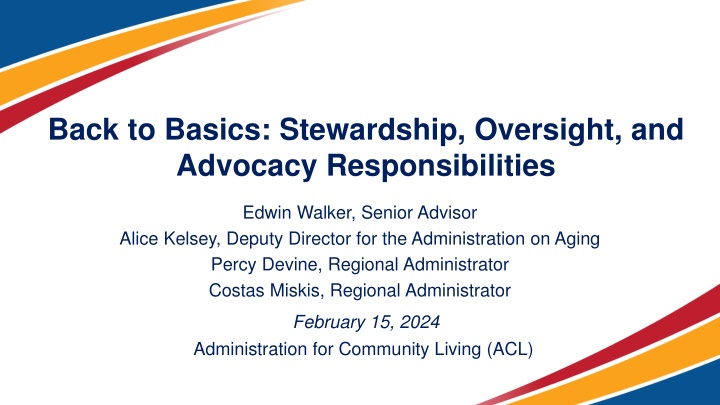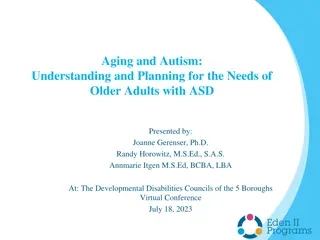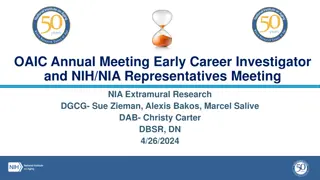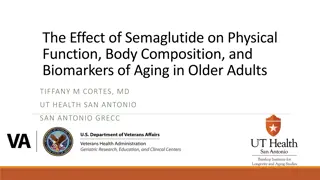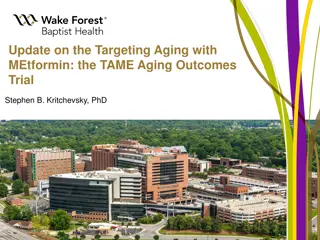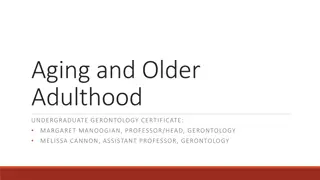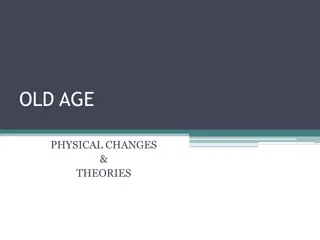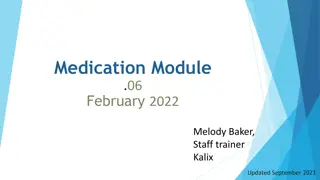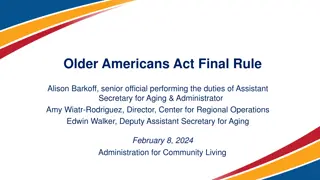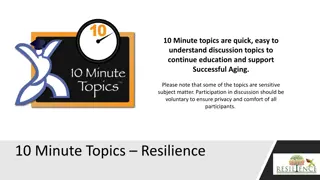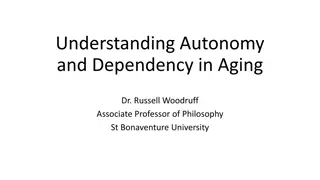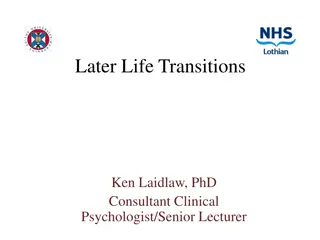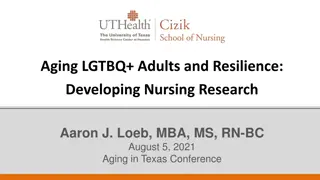Back to Basics: Responsibilities in Aging Administration
Exploring stewardship, oversight, and advocacy roles in aging administration to align with the Older Americans Act. Discussing the importance of holistic program management, integrity in advocacy activities, and current trends driving the need for a back-to-basics approach.
Download Presentation

Please find below an Image/Link to download the presentation.
The content on the website is provided AS IS for your information and personal use only. It may not be sold, licensed, or shared on other websites without obtaining consent from the author.If you encounter any issues during the download, it is possible that the publisher has removed the file from their server.
You are allowed to download the files provided on this website for personal or commercial use, subject to the condition that they are used lawfully. All files are the property of their respective owners.
The content on the website is provided AS IS for your information and personal use only. It may not be sold, licensed, or shared on other websites without obtaining consent from the author.
E N D
Presentation Transcript
Back to Basics: Stewardship, Oversight, and Advocacy Responsibilities Edwin Walker, Senior Advisor Alice Kelsey, Deputy Director for the Administration on Aging Percy Devine, Regional Administrator Costas Miskis, Regional Administrator February 15, 2024 Administration for Community Living (ACL)
Welcome Edwin Walker, Senior Advisor Kari Benson, Deputy Assistant Secretary for Aging 2
Agenda Back to Basics Final Rulemaking and Implementation Advocacy Oversight, Monitoring, Data & Reporting Resources Please note: When a hyperlink is provided on a slide, the notes section will include the full website link. 3
What does back to basics mean? Meeting the mission and vision of the Older Americans Act (OAA) by holistic program management: Program, fiscal, data, evaluation, training, communications, policies & procedures, all in alignment Maintaining integrity of advocacy activities; and Targeted, effective, efficient activities 4
Back to Basics: Why now? Coincides with the first comprehensive update to OAA program regulations in 36 years Emerging from the COVID-19 pandemic Recent spate of retirements New and developing business opportunities Increased interest in stewardship of public funds 5
What does a balanced, collaborative approach look like? Collaboration is required in the mission of both State agencies and area agencies( 1321.5 Mission of the State agency; 1321.55 Mission of the area agency). Development of your Aging Network State and Area Plans on Aging ( 1321.27; 1321.65) Coordination with Tribes and Title VI grantees ( 1321.53 State agency Title III and Title VI coordination responsibilities; 1321.69 Area agency on aging Title III and Title VI coordination responsibilities; 1321.95 Service provider Title III and Title VI coordination responsibilities; 1322.31 Title VI and Title III coordination) Policies and Procedures ( 1321.9 State agency policies and procedures; 1321.59 Area agency policies and procedures; 1321.73 Policies and procedures [Service providers]) Communications and training Working with boards, committees, commissions on aging, and other partners 6
What does stewardship really mean? We cannot achieve the vision and goals of the OAA without proper stewardship of federal spending OAA grantees and sub-grantees must meet all applicable laws, regulations, and terms and conditions of Federal awards Staying focused on the intent of the OAA: serving older adults in greatest social need (GSN) and greatest economic need (GEN) ( 1321.3 Definitions, 1321.27 Content of State plan; 1321.65 Submission of an area plan and plan amendments to the State agency for approval.) Ensuring conflicts of interest (COIs) are appropriately addressed ( 1321.47 Conflicts of interest policies and procedures for State agencies; 1321.67 Conflicts of interest policies and procedures for area agencies on aging) 7
Final Rule making & Implementation 8
Purpose of the Final Rule Updating the OAA Regulations Update regulations to align with the current statute Reflect the needs of today s older adults Promote appropriate stewardship of OAA resources Clarify programmatic requirements Support the national aging network that delivers OAA services Improve program implementation to better serve older adults and caregivers 9
Effective and Compliance Dates Effective Date: 30 days after publication in the Federal Register, or March 15, 2024. Compliance Date: October 1, 2025. As the final rule goes into effect, we look forward to providing technical assistance and engaging with stakeholders regarding implementation of the final rule. For State Units on Aging (SUAs) that are unable to meet the October 1, 2025 compliance date, ACL will have a supportive corrective action process in place. 10
Layout of the Final Rule: Preamble (Sections I-III) & Regulatory Text The Final Rule has two basic sections: 1. The first portion is preamble: Background, explanation of provisions of the final rule, analysis and responses to public comments , required regulatory analyses 2. The second portion is the final regulatory text in full for 45 CFR parts 1321 (Title III), 1322 (Title VI), and 1324 (Title VII) For a more detailed orientation to the final rule (e.g., slides from the 2/8 national stakeholder webinar, additional resources), please visit ACL's OAA Regulations webpage: https://acl.gov/OAArule 11
General Note on the OAA Final Rule The vast majority of what is included in the final rule are long-established OAA requirements i.e., reaffirming what is in statute, prior regulations, or existing policies rather than new requirements. 12
Questions to ask when it comes to requirements and flexibilities: Is this an OAA law or regulation requirement? Is it another federal law or regulation? Is this a state policy or procedure? Is this an area agency on aging (AAA) policy or procedure? Is this a local service provider policy or procedure? Based on who is responsible for the requirement, what are your options for changing it or advocating for changing it? 13
Policies and Procedures Policies and procedures at the state, AAA, and service provider level are essential for proper stewardship of Federal grant funds, and must meet the following requirements (not an exhaustive list): Older Americans Act, Public Law (P.L.) 89-73 as amended through P.L. 116-131, enacted March 25, 2020. Executive Orders 45 CFR parts 1321, 1322, 1324: Older Americans Act Regulations 45 CFR part 75 & 2 CFR part 200: Uniform Administrative Requirements, Cost Principles, and Audit Requirements ACL policies and procedures Award terms and conditions State and local laws and regulations 14
Review how you currently implement OAA requirements Identify existing: Policies and procedures Administrative rules Program manuals, training materials Program instructions, area plan templates AAA and/or service provider contracts Reporting requirements Review and assess 15
Decide how you will make updates Identify what needs to be updated Your SUA s existing policies and procedures may already fully meet OAA Final Rule requirements E.g., 1321.49 Intrastate funding formula Some OAA Final Rule requirements allow the SUA to exercise certain flexibilities, at the SUA s option E.g., 1321.101 Flexibilities under a major disaster declaration Prioritize where will you start? How will you break into manageable bites? Identify who is responsible for determining the what/who/how One or more individual staff members? Workgroups? 16
Identify who needs to be involved in the updates State, AAA, service providers ( 1321.7 Organization and staffing of the State agency; 1321.57 Organization and staffing of the area agency; 1321.79 Responsibilities of service providers under State and area plans); Tribes, Tribal organizations, and Title VI program directors ( 1322.19 Responsibilities of service providers; 1322.31 Title VI and Title III coordination) Executive leadership; Program managers; Board/Advisory Council members ( 1321.63 Area agency advisory council); Community members via public input processes; Staff members and volunteers; Workgroups; and/or Other 17
Collaboration Examples Example: addressing new greatest social need definition ( 1321.3; 1321.27; 1321.65) May review data, conduct public input process, meet with AAAs/service providers, discuss with organizations serving identified populations Example: state fiscal staff to review compliance with existing fiscal requirements ( 1321.9(c)(2)) May create cross-departmental workgroup to ensure fiscal, data, and program management are aligned 18
How will you communicate updates? Consider your collaborative approach toward communicating revised guidance, program manuals, contracts, etc.: Centralized website repository of documents State and local conferences Webinars SUA meetings with AAAs; AAA meetings with service providers Workgroups Meetings with tribes and tribal organizations Facilitating peer-to-peer sharing opportunities 19
Once updates are made How will you monitor them? How will you evaluate them? How will you periodically review, update, and train your network? 20
Advocacy 21
Celebrating the Older Americans Act The Older Americans Act clearly affirms our nation s sense of responsibility toward the well-being of all of our older citizens. But even more, the results of this act will help us expand our opportunities for enriching the lives of all of our citizens in this country, now and in the years to come. President Lyndon B. Johnson upon signing the OAA in 1965 22
Advocacy The role of the State agency is to, serve as an effective and visible advocate for older individuals by reviewing and commenting upon all State plans, budgets, and policies which affect older individuals and providing technical assistance to any agency, organization, association, or individual representing the needs of older individuals[.] -OAA Section 305(a)(1)(D) The AAA will, serve as the advocate and focal point for older individuals within the community by (in cooperation with agencies, organizations, and individuals participating in activities under the plan) monitoring, evaluating, and commenting upon all policies, programs, hearings, levies, and community actions which will affect older individuals[.] -OAA Section 306(a)(6)(B) 23
AAA Advocacy Responsibilities Special advocacy responsibilities apply upon designation as a AAA ( 1321.19 Designation of and designation changes to area agencies; 1321.61 Advocacy responsibilities of the area agency.) Serve as public advocate for the development and enhancement of comprehensive and coordinated community-based systems of services in each community throughout and specific to each planning and service area (PSA) ( 1321.13 Designation of and designation changes to planning and service areas.) Understand the needs of and represent the best interests of older adults and caregivers (particular attention on greatest social need and greatest economic need) at all levels (from local, county, regional to federal) and in interactions with different advocacy organizations, collaborations, and coalitions( 1321.3). 24
Examples of Effective Advocacy Additional funding for services, expansion of services, elimination of wait lists Better outreach and support to those in greatest social need and greatest economic need Systems to better recognize and address needs of older adults and family caregivers Addressing ageism and promoting age-friendly policies Participation in advocacy coalitions Education to local, state, and federal legislators and decision makers 25
State and Area Plans on Aging The State agency is required to submit a state plan, that is informed by area plans, and have input processes ( 1321.27; 1321.29 Public participation). The AAA is required to submit an area plan that is informed by local needs and public input ( 1321.65). State and area plans can be used in promoting your local and state advocacy messages. 26
Conflicts of Interest Because of the advocacy responsibilities, ensuring conflicts of interest avoided, identified, and remedied at the individual and organizational level is critical to the integrity of the OAA ( 1321.9; 1321.59). COI provisions of the final rule help to ensure that State agencies, AAAs, and service providers carry out the objectives of the Act consistent with the best interests of those they serve ( 1321.47; 1321.67) 27
Oversight, Monitoring, Data & Reporting 28
Oversight and Monitoring The OAA final rule: Clarifies the state agency s and AAA s responsibility to establish and maintain policies and procedures to monitor the programmatic and fiscal performance of programs and activities carried out under Title III of the OAA ( 1321.9(a) and (b); 1321.59(a) and (b)). ACL is responsible for ensuring grantees are conducting oversight and monitoring of OAA programs & requirements 29
Program Oversight & Monitoring Monitoring can include: Identifying risks Utilizing a checklist or other monitoring tool Reviewing audit reports Holding regular touch base meetings with subgrantees Reviewing monthly/quarterly/annual fiscal and program data reports Observing program activities (e.g., conducting site visits, attending classes, presentations, or public hearings) Reviewing technical assistance and other questions 30
Program Monitoring Examples An SUA compares a AAA s program reports with, and assesses progress on, the goals in their area plan ( 1321.9(c)(4); 1321.65). A AAA conducts a site visit to a nutrition program provider to ensure they are: meeting dietary, health, safety and other program requirements ( 1321.59(b); 1321.87 Nutrition services), targeting priority service populations (GSN, GEN) ( 1321.3; 1321.83 Client and service priority), and submitting accurate data on their reports ( 1321.9(b)). 31
Fiscal Oversight & Monitoring It is critical to have effective systems in place to ensure appropriate and efficient oversight: The rule includes various requirements for State agencies to establish fiscal policies and procedures related to the Act ( 1321.9(c)(2)) and AAAs to establish policies and procedures in compliance with those ( 1321.59(a)). e.g., match, transfers, maintenance of effort The State agency is responsible for monitoring the program and financial activities of subrecipients and subgrantees, including: (i) Evaluating each subrecipient's risk of noncompliance to ensure proper accountability and compliance with program requirements and achievement of performance goals; (ii) Reviewing subrecipient policies and procedures; and (iii) Ensuring that all subrecipients and subgrantees complete audits as required in 2 CFR part 200, subpart F and 45 CFR part 75, subpart F. The AAA is also responsible for monitoring service providers in compliance with the AAA s policies and procedures ( 1321.59(b)). 32
Fiscal Monitoring Examples Conduct financial monitoring activities ( 75.341-.343 Performance and Financial Monitoring and Reporting) Reconcile invoices to actual served reimbursement requests to actual expenditures advance payments to actual expenditures ( 1321.9(c)(2)(xviii)) Separation of duties, with appropriate controls in place, including where cash is received (e.g., program income) Program income properly reported and expended ( 1321.9(c)(2)(xii)) Reviewing documentation of in-kind expenditures Review expenditures to ensure meeting Long-Term Care Ombudsman (LTCO) expenditure minimums ( 1321.9(c)(2)(vii)) 33
Program Reporting Requirements ACL has implemented a national reporting system (Older Americans Act Performance System (OAAPS)). State Program Report (SPR): States, AAAs, and service providers are required to collect and report data on their OAA Title III (except Ombudsman) & Title VII Chapter 3 & 4 program activities (OAA Section 307 and Final Rule 1321.9(b)) National Ombudsman Reporting System (NORS): The State Ombudsman is required to collect and report data on their Ombudsman program activities (Title III and VII) ( 1324.13(g) [Functions and responsibilities of the State Long-Term Care Ombudsman]) Title VI Program Performance Report (PPR): Title VI grantees are required to collect and report data on their program activities ( 1322.13(b) [Title VI policies and procedures]). 34
Ombudsman Reporting Requirements The State agency must require the Ombudsman program to submit an annual report that (OAA section 712(h)): describes the activities carried out by the Office, evaluates problems experienced by residents, analyzes the success of the Ombudsman program, and makes recommendations to improve the quality of life of residents. The annual report shall provide various information including analysis of Ombudsman program data ( 1324.13(g)) This information is separate from and in addition to the data reported annually to ACL through the National Ombudsman Reporting System (NORS). 35
Other Program Reporting Requirements Your SUA, AAA, Tribe/Tribal organization, and/or service provider may: Incorporate data projections into State/area plans or other internal planning activities Have additional reporting expectations Use various software platforms to gather data submitted to ACL via OAAPS 36
Why The Network Collects Data on OAA Programs Demonstrate Accountability & Stewardship Justify Continued Programming & Increases in Funding Educate & Advocate Understand Needs & Trends Manage Programs Drive Program Improvement Improve Allocation of Resources 37
ACLs Use of Data in Our Stewardship, etc. We use the data you share with ACL to demonstrate accountability and stewardship: Budget Justification and Related Documents Annual Performance Plan and Report Older Americans Act Report to Congress Other: Risk Management, Government Accountability Office (GAO), Congressional inquiries Impact of the OAA 38
Targeting & Efficiency How do you use the data you collect? Targeting: Serving those with greatest social need & greatest economic need? ( 1321.3) What: Menu of services you (or subrecipients) are providing? 1321.85 Supportive services; 1321.87 Nutrition services; 1321.89 Evidence- based disease prevention and health promotion services; 1321.91 Family caregiver support services. 1321.93 Legal assistance Efficiency: Units per person served and expenditures per unit? With what sources of funding? Who do your share your data with: Reports to local, regional, tribal & state entities? 39
Quality Does the data reflect reality? Is the data accurate & complete? If so, are you happy with the reality or do you want to change it? Does your program data reflect your policies and goals? Do you want to change your policies and goals? 40
Stewardship: Maintaining Balance Quality Targeting Efficiency 41
Resources 42
Timeline Review The OAA final rule is effective on March 15, 2024. ACL will provide training, technical assistance, and work with state agency and tribal organization grantees to come into compliance. AAAs should work closely with their state agency and service providers should work closely with their AAAs or state agency for single planning and service area (PSA) states. The compliance date is October 1, 2025. 43
OAA Final Rule Resources The Older Americans Act Final Rule ACL's OAA Regulations webpage: ACL.gov/OAArule Recordings of and Slides from Webinars Fact sheets ACL announcement and additional resources Information on upcoming webinars or trainings Coming soon: Slides and recording of this webinar Please join us for a Back to Basics webinar on Fiscal Policies and Procedures on 4/4 at 2 p.m. Eastern 44
Upcoming What s next March 18-21: Tribal consultation & Title VI conference: https://teya.swoogo.com/2024-title-vi April 4: 2 p.m. Eastern Back to Basics - Fiscal Policies and Procedures Upcoming Sessions: Nutrition; Legal Assistance and Guardianship; State and Area Plans on Aging; Contracts & Commercial Relationships; Emergency and Disaster Requirements; Title III & VI Coordination; and more. 45
Thank You! 46
